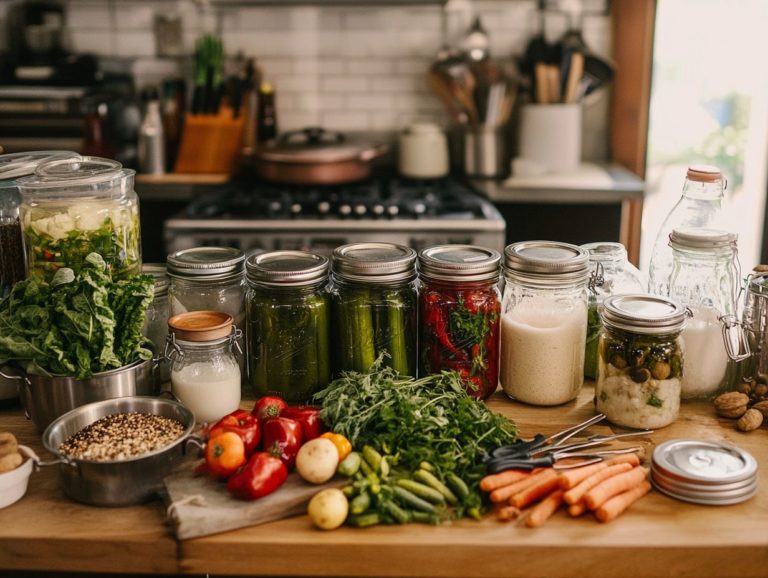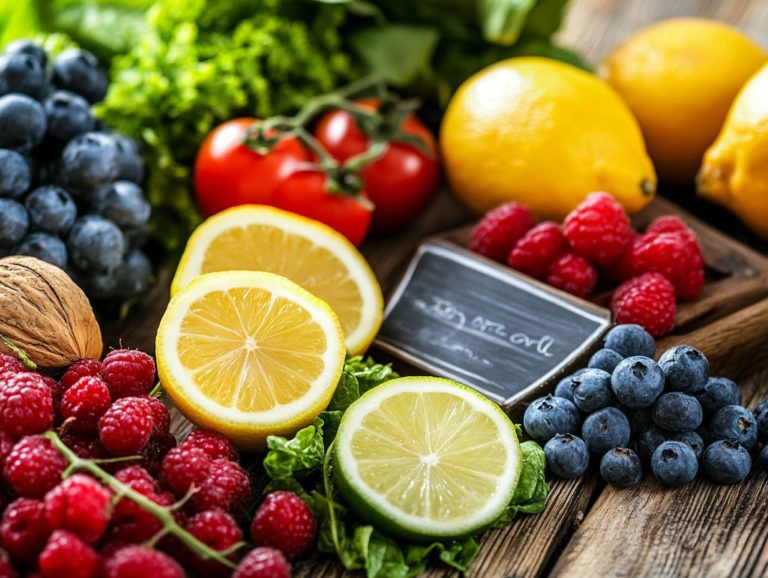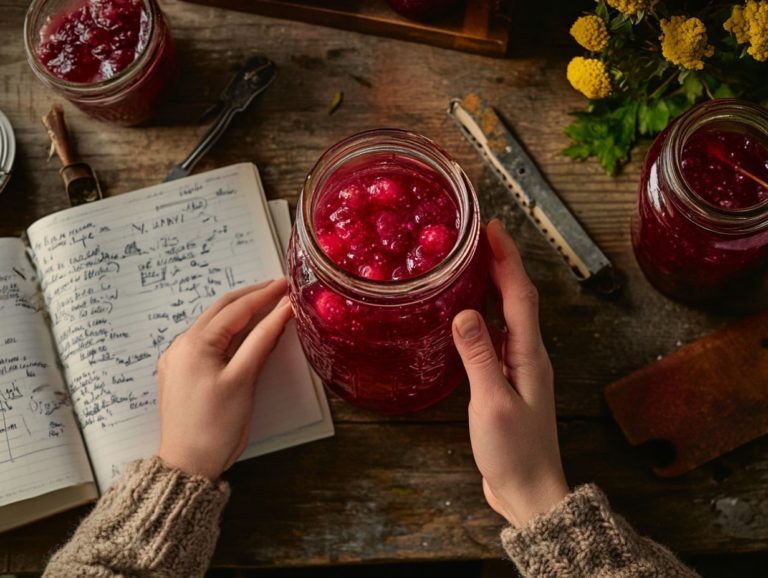How to Handle Canning Jar Leakage
Canning is an excellent method for preserving your favorite foods. However, grappling with leaky jars can be quite a headache, especially considering the quality of the seal.
To truly excel as a home canner, it s crucial to understand the causes of leakage and recognize the signs. Learning how to fix and prevent these pesky issues during the canning process is essential.
This article delves into the reasons behind canning jar leaks. It provides practical solutions and essential safety tips to ensure your preserved foods stay fresh and secure, highlighting the importance of a good seal.
Dive in to ensure your canning adventures are completely worry-free and successful!
Contents
Key Takeaways:

- Leaks can happen due to improper sealing, damaged jars, or incorrect storage. Identifying the source is key.
- Look for wet jars, cracks, or unusual sounds when handling.
- To prevent leaks, use quality lids, leave proper headspace, and store jars in a cool, dry place.
Why Canning Jar Leakage Matters
Canning jar leakage is a vital concern in the food preservation process, as it directly relates to the quality of the seal. If you encounter issues, knowing what to check when jars don’t seal can help ensure your food stays preserved.
A poor seal can significantly impact the quality of your canned food, especially regarding liquid loss. Understanding the factors contributing to jar leakage is important for effective food preservation.
Seal failures can occur when the canning process is not executed correctly. It’s essential to check seals to ensure both safety and quality.
Common Causes of Leakage
Canning jar leakage can arise from several factors, including seal failure due to temperature fluctuations during the canning process. To avoid this, it’s important to learn how to properly seal your canning jars.
Using a pressure canner without enough time for food to heat properly can lead to inadequate sealing. Improper cooling or heating can stress the seals, increasing the risk of leakage.
It s vital to fill jars correctly with hot food. Overfilling or using cold food can prevent seals from forming properly.
Maintaining the right temperature and avoiding air bubbles are crucial for effective sealing. By following best practices like ensuring clean jars and proper headspace filling, you can significantly decrease the chances of leakage.
Identifying and Addressing Leaks
Identifying and addressing leaks in canning jars is essential for maintaining food safety and quality. If you encounter issues, knowing what to do if canning jars crack can help. Recognizing the signs of leakage early allows for effective solutions.
Checking seals and repacking jars as necessary, especially after using a pressure canner, can help. Ensuring that your jars are clean before sealing adds an extra layer of protection.
Signs of Leakage
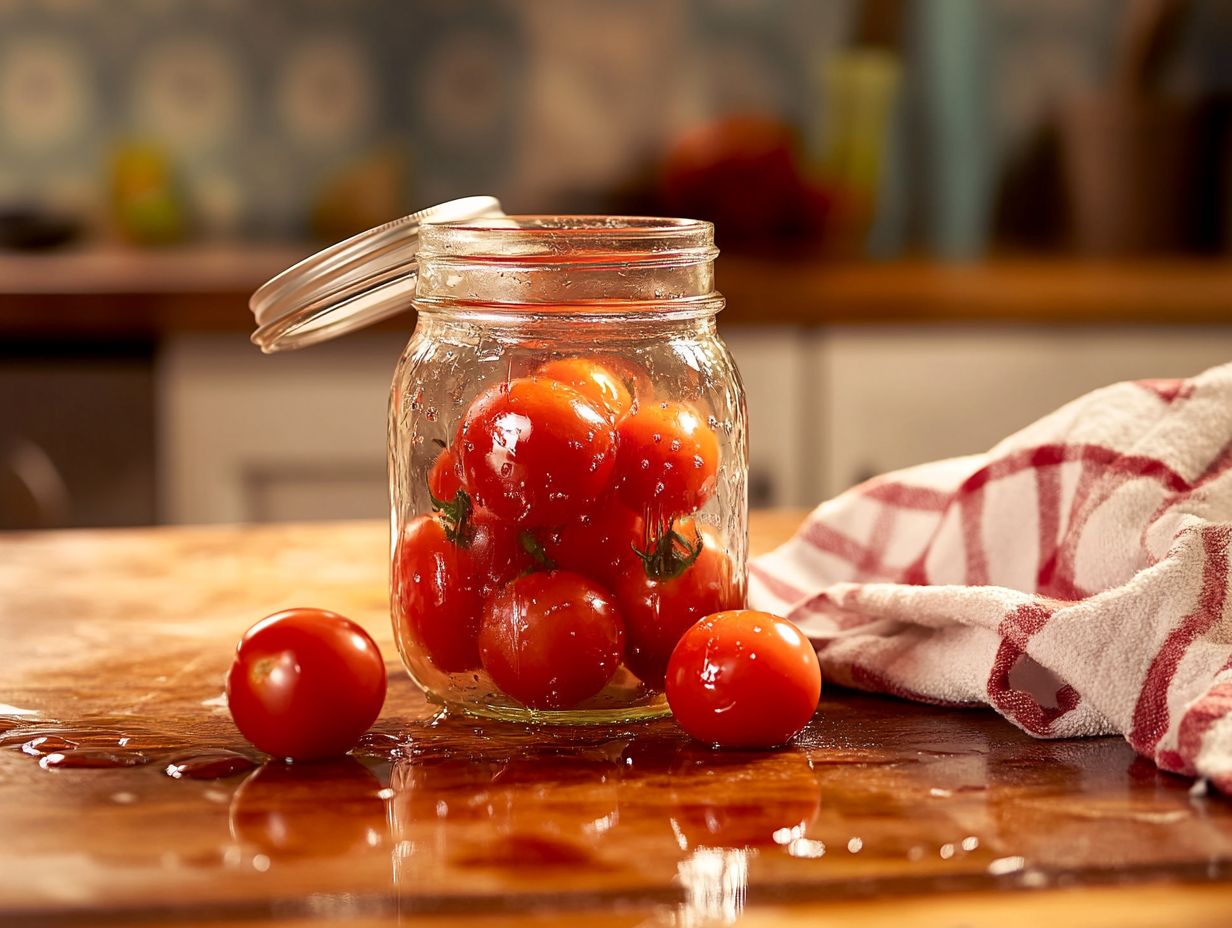
Signs of leakage in your canning jars can include a poor seal, noticeable loss of liquid, or the presence of siphoning. You may notice a distinct concave shape in the lid.
Keep an eye out for residue around the rim or on the jar’s exterior, suggesting that contents have escaped. Physical signs like a warped lid or rust can indicate compromised quality.
To check if the jar seal is intact, gently press down on the center of the lid. If it pops back up, that s a clear sign that air has made its way inside.
Liquid loss jeopardizes the preservation of your food and can lead to spoilage and contamination. Inspecting each jar systematically is crucial to avoid potential health hazards.
How to Fix Leakage
To address leakage in your canning jars, start by gently tapping the lid to ensure a proper seal forms. If that doesn’t do the trick, you might need to press down on the lid or even consider handling overfilled canning jars to tackle any potential safety concerns.
Maintaining the integrity of each jar is essential in preventing spoilage and foodborne illnesses. When inspecting your jars, examine the lid’s surface for any deformities or dents that could compromise the seal. If you’ve reused a lid several times, consider replacing it, as a worn lid may not seal as effectively. Keep in mind that if a seal has been broken especially if you notice leakage you may need to repack the jars with fresh ingredients.
Neglecting these issues can lead to bacterial growth or unexpected pressure changes, so proper maintenance is crucial for safe home canning.
Preventing Canning Jar Leakage
To prevent canning jar leakage, you must pay close attention. This includes mastering the art of proper sealing, ensuring you fill with the right amount of headspace, and managing temperature fluctuations throughout the canning process. Additionally, it’s important to know what to do if your canning jar breaks to avoid any mishaps.
By doing so, you can maintain an effective seal and preserve your hard work.
Tips for Proper Sealing and Storage
Using clean jars and the right methods, like a pressure canner or a boiling water bath, along with hot pack techniques, is essential for achieving proper sealing and storage of your canned goods.
It’s also important to eliminate any contaminants before filling your jars. Make sure to thoroughly wash and sterilize all jars; otherwise, bacteria could jeopardize the integrity of your preserved items, leading to potential safety issues.
Once your jars are filled, maintaining an optimal sealing environment becomes crucial. Always inspect the lids for any signs of wear or damage. After sealing, consider ideal storage conditions, such as a cool, dark place that helps prevent potential leakage and spoilage.
By following these best practices, you can savor the flavors of your home-canned goods safely and deliciously for months to come.
Using Leaky Jars Safely
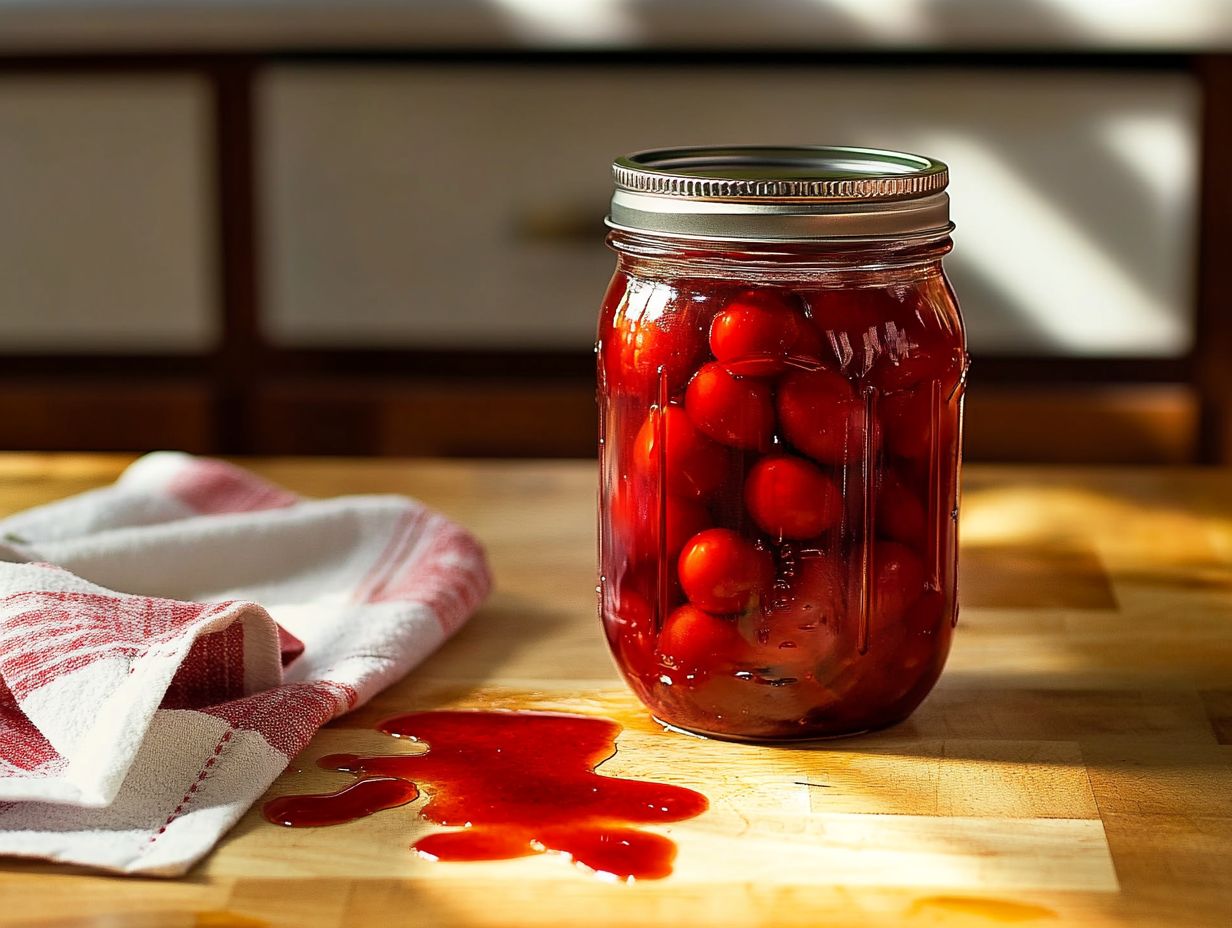
Ensuring the safe use of leaky jars is paramount in food preservation. Improper sealing can pose serious safety risks, making it essential for you to repack jars correctly or consider discarding them altogether.
Being diligent helps keep your food safe and delicious!
Safety Precautions and Recommendations
Safety precautions and recommendations from the National Center for Home Food Preservation underscore the importance of adhering to best practices in canning to avoid potential safety issues and ensure food quality.
To yield safe and delicious results, it’s essential for you to use tested recipes and the right canning equipment. This means carefully selecting appropriate jars, lids, and processing methods tailored to the specific type of food you re preserving.
Pay attention to signs of spoilage, such as bulging lids or unusual odors, as they can signal a breach in food safety. Regularly updating your knowledge of guidelines from trusted organizations will significantly enhance your safety measures and prolong shelf life, leading to a more rewarding food preservation experience.
Frequently Asked Questions
What causes canning jar leakage?
Canning jar leakage can be caused by a variety of factors such as improper sealing, damaged jars, or overfilling the jar. To avoid these issues, preventing jar breakage during canning is crucial.
How do I prevent canning jar leakage?
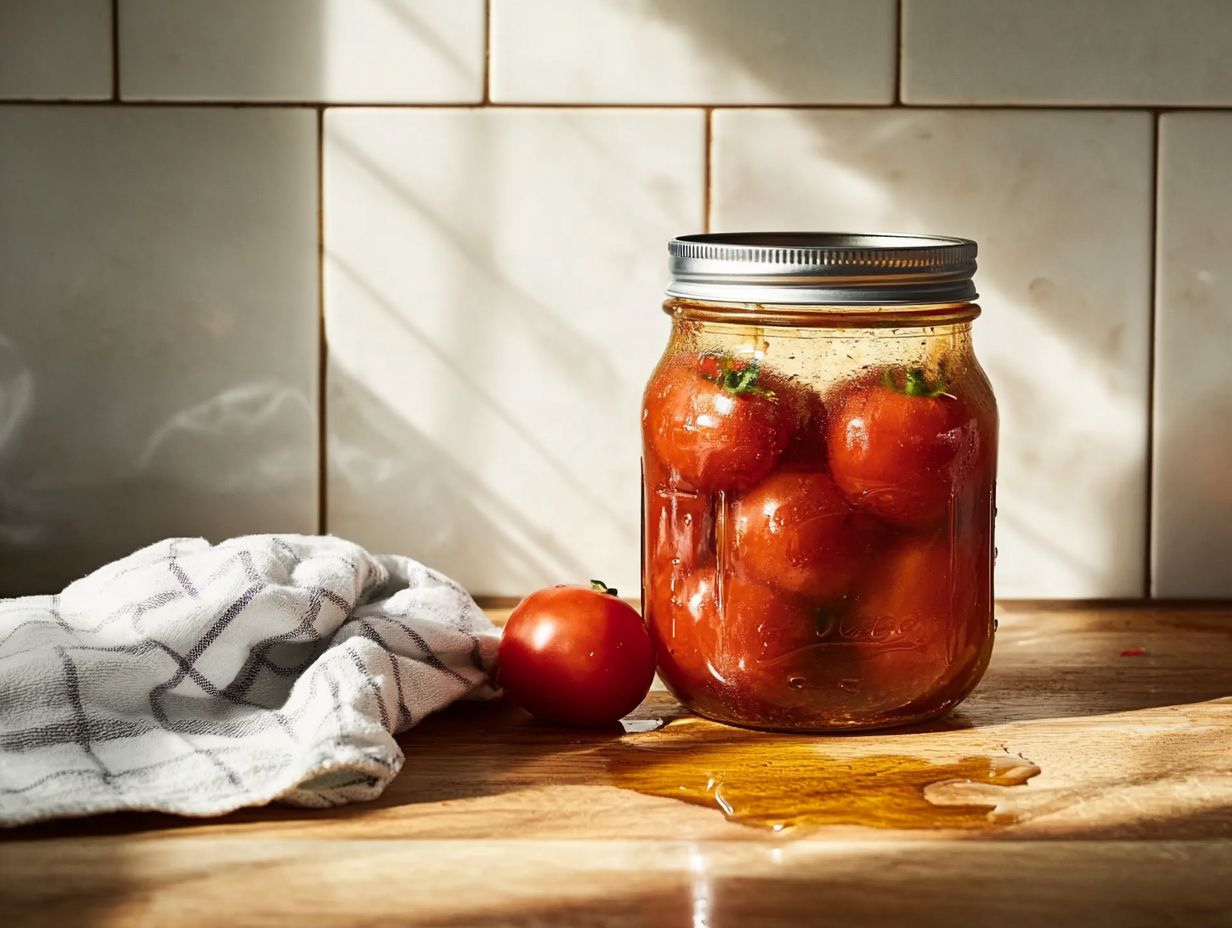
To prevent canning jar leakage, make sure to properly seal the jar and check for any damages before using. Additionally, to avoid breakage, refer to this guide on how to prevent canning jar breakage and avoid overfilling the jar.
Can I still use a jar with minor leakage?
It is not recommended to use a jar with any type of leakage, as it can compromise the safety and quality of the preserved food.
How can I fix a canning jar with leakage?
If the leakage is minor, you can try resealing the jar by heating it in a water bath or using a new lid. However, if the leakage is significant, it is best to discard the jar and its contents.
Act quickly to ensure your home-canned goods are safe and tasty!
Can canning jar leakage be harmful?
Yes, canning jar leakage can introduce germs into the preserved food. This makes it unsafe to eat.
How should I store jars with canned food to prevent leakage?
Store jars in a cool, dry place. Don’t stack them on top of each other, as that may damage the lids and cause leaks.
Check the jars regularly for any signs of damage or leakage. Keeping your food safe is a top priority!

